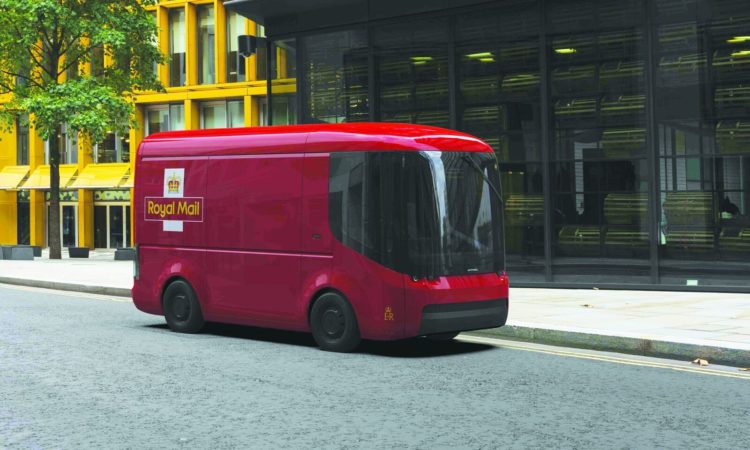

Arriving Soon: Affordable Commercial EVs
Arrival, an electric vehicle manufacturer based in the United Kingdom, has a vision: improve the environment by making electric vehicles (EVs) as affordable as their fossil-fueled counterparts. “The company was established in 2015 with the simple purpose of removing all barriers to true widespread adoption of electric vehicles,” says Patrick Bion, chief of product. Composite materials are key to the company’s game plan. Arrival’s primary focus is commercial vans because it wants to improve the air quality in cities as quickly as possible. There’s also a real need for affordable commercial EVs. “Customers around the world – big fleets and small fleets – have a great desire for electric vehicles, but the fact remains they don’t know where to purchase them,” says Bion. “They currently have a choice to either buy a diesel vehicle or pay a huge premium to buy an electric commercial vehicle.” To keep costs down, Arrival is reimagining every aspect of vehicle production, from structures and hardware to manufacturing processes. “Ultimately, it’s taking away all of the assumptions and the legacy that gets built into a new vehicle that comes from a traditional manufacturer. We are in the very fortunate position where we can evaluate everything that the industry does well and what it does badly to design our vehicles from the ground up,” Bion explains. One big change is that Arrival builds its vans on what the company calls a “skateboard platform” – a completely flat chassis on wheels that houses the battery and motor and provides much of the vehicle’s structural performance. That enables the company to develop and produce new bodies for the platform base in just a matter of months, unlike the years it takes traditional vehicle manufacturers to design and build different models. Using composite materials for many parts of the van, Arrival can slash the time and cost involved in prototyping and manufacturing its EVs. It uses readily available thermoplastic materials, engineering them slightly to meet its vehicles’ unique requirements. The company remains tight-lipped about the reinforcement material, only saying that it was developed, tooled and built in-house. “The driver was to create a material that we can process at low pressure,” says Bion. “It is fully recyclable. We’re trying to build a circular economy for our vehicles.” The composite materials provide the vehicle with UV resistance, corrosion resistance and the durability to last 15 to 20 years. They also give Arrival more finishing options; the vehicles can be left in their raw state, colored during manufacture, painted or vinyl wrapped to meet customers’ demands. Structural adhesives bond the vehicle sections together, eliminating the need for labor-intensive and time-consuming welding. “Another benefit of the composite approach is that we can customize the material based on the performance that a certain part of the vehicles need. We can integrate metallic structures or UG [unidirectional glass] composites for added thickness and strength. Or we can put cores in the side to get stiffness,” Bion explains. Once the vehicle design is complete, cycle time for parts production is very fast. When the parts are ready, it takes just four hours for robots and workers to build a vehicle. Since Arrival can make changes to the van’s body quickly and at low cost, customers can choose the van size, shelving arrangements, door style and so on that they prefer. There’s plenty of room for customization; the Arrival vans have about 40% more cargo space than equivalent fuel-powered vehicles, according to the company. “Designing a vehicle from the ground up and designing it with composite materials facilitates a lot of that,” says Bion. Aware that commercial fleet customers want to avoid downtime, Arrival has built its electric vans for easy repair. The areas of a vehicle that experience frequent damage from scraping trees, hitting curbs and similar incidents can be easily removed and recycled, and so can larger structural parts. The damaged parts can be recycled and that material reused. Arrival’s plan is to build 100,000-square-foot production facilities that replicate their assembly process in many locations throughout the world. With that approach, the company will be able to reach large numbers of customers without investing vast amounts of capital or time to get production started. In the past few years, Arrival has been testing its electric vehicles in the United Kingdom with customers such as the Royal Mail, UPS and John Lewis (a department store chain). The EVs are also being tested in some U.S. cities. These commercial vans are older models, but Arrival will put the newer, built-from-the-ground-up models on the road in 2020. Arrival doesn’t see the need to focus on autonomous commercial vehicles just yet. However, another part of the company is building Roborace, an autonomous electric vehicle that includes artificial intelligence. Some of the intelligent technology used in Roborace will be incorporated into the commercial EVs. That technology will help keep drivers safer and provide driving data that fleet owners and their insurance companies might want. Arrival plans to test its autonomous commercial vehicles on both public and private roads in 2020. In all its work, Arrival keeps one primary objective in mind – producing commercial electric vehicles at a competitive cost. The company hopes to keep the cost of the van at about $44,000 compared to equivalent vans from Mercedes and Volkswagen that cost approximately $66,000 and $77,000 respectively. “If we address the price of the vehicle, that’s the primary concern of fleets around the world,” Bion says.

SUBSCRIBE TO CM MAGAZINE
Composites Manufacturing Magazine is the official publication of the American Composites Manufacturers Association. Subscribe to get a free annual subscription to Composites Manufacturing Magazine and receive composites industry insights you can’t get anywhere else.



